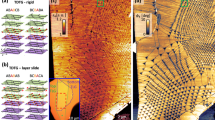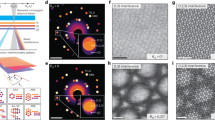Abstract
Atomic reconstruction has been widely observed in two-dimensional van der Waals structures with small twist angles1,2,3,4,5,6,7. This unusual behaviour leads to many novel phenomena, including strong electronic correlation, spontaneous ferromagnetism and topologically protected states1,5,8,9,10,11,12,13,14. Nevertheless, atomic reconstruction typically occurs spontaneously, exhibiting only one single stable state. Using conductive atomic force microscopy, here we show that, for small-angle twisted monolayer–multilayer graphene, there exist two metastable reconstruction states with distinct stacking orders and strain soliton structures. More importantly, we demonstrate that these two reconstruction states can be reversibly switched, and the switching can propagate spontaneously in an unusual domino-like fashion. Assisted by lattice-resolved conductive atomic force microscopy imaging and atomistic simulations, the detailed structure of the strain soliton networks has been identified and the associated propagation mechanism is attributed to the strong mechanical coupling among solitons. The fine structure of the bistable states is critical for understanding the unique properties of van der Waals structures with tiny twists, and the switching mechanism offers a viable means for manipulating their stacking states.
This is a preview of subscription content, access via your institution
Access options
Access Nature and 54 other Nature Portfolio journals
Get Nature+, our best-value online-access subscription
$29.99 / 30 days
cancel any time
Subscribe to this journal
Receive 12 print issues and online access
$259.00 per year
only $21.58 per issue
Buy this article
- Purchase on Springer Link
- Instant access to full article PDF
Prices may be subject to local taxes which are calculated during checkout




Similar content being viewed by others
Data availability
The authors declare that the main data supporting the findings of this study are available within the paper. Extra data are available from the corresponding authors upon reasonable request. Source data are provided with this paper.
References
Yoo, H. et al. Atomic and electronic reconstruction at the van der Waals interface in twisted bilayer graphene. Nat. Mater. 18, 448–453 (2019).
Weston, A. et al. Atomic reconstruction in twisted bilayers of transition metal dichalcogenides. Nat. Nanotechnol. 15, 592–597 (2020).
Kerelsky, A. et al. Maximized electron interactions at the magic angle in twisted bilayer graphene. Nature 572, 95–100 (2019).
Jin, C. et al. Observation of moiré excitons in WSe2/WS2 heterostructure superlattices. Nature 567, 76–80 (2019).
Huang, S. et al. Topologically protected helical states in minimally twisted bilayer graphene. Phys. Rev. Lett. 121, 037702 (2018).
Andersen, T. I. et al. Excitons in a reconstructed moiré potential in twisted WSe2/WSe2 homobilayers. Nat. Mater. 20, 480–487 (2021).
Rosenberger, M. R. et al. Twist angle-dependent atomic reconstruction and moiré patterns in transition metal dichalcogenide heterostructures. ACS Nano 14, 4550–4558 (2020).
Cao, Y. et al. Correlated insulator behaviour at half-filling in magic-angle graphene superlattices. Nature 556, 80–84 (2018).
Cao, Y. et al. Unconventional superconductivity in magic-angle graphene superlattices. Nature 556, 43–50 (2018).
Rickhaus, P. et al. Transport through a network of topological channels in twisted bilayer graphene. Nano Lett. 18, 6725–6730 (2018).
Sharpe, A. L. et al. Emergent ferromagnetism near three-quarters filling in twisted bilayer graphene. Science 365, 605–608 (2019).
Xu, S. G. et al. Giant oscillations in a triangular network of one-dimensional states in marginally twisted graphene. Nat. Commun. 10, 4008 (2019).
Shimazaki, Y. et al. Strongly correlated electrons and hybrid excitons in a moiré heterostructure. Nature 580, 472–477 (2020).
Walet, N. R. & Guinea, F. The emergence of one-dimensional channels in marginal-angle twisted bilayer graphene. 2D Mater. 7, 015023 (2019).
Jiang, Y. et al. Charge order and broken rotational symmetry in magic-angle twisted bilayer graphene. Nature 573, 91–95 (2019).
Xie, Y. et al. Spectroscopic signatures of many-body correlations in magic-angle twisted bilayer graphene. Nature 572, 101–105 (2019).
Lu, X. et al. Superconductors, orbital magnets and correlated states in magic-angle bilayer graphene. Nature 574, 653–657 (2019).
Park, J. M., Cao, Y., Watanabe, K., Taniguchi, T. & Jarillo-Herrero, P. Tunable strongly coupled superconductivity in magic-angle twisted trilayer graphene. Nature 590, 249–255 (2021).
Wijk, M. M. V., Schuring, A., Katsnelson, M. I. & Fasolino, A. Relaxation of moiré patterns for slightly misaligned identical lattices: graphene on graphite. 2D Mater. 2, 034010 (2015).
Dai, S., Xiang, Y. & Srolovitz, D. J. Twisted bilayer graphene: moiré with a twist. Nano Lett. 16, 5923–5927 (2016).
Zhang, K. & Tadmor, E. B. Structural and electron diffraction scaling of twisted graphene bilayers. J. Mech. Phys. Solids 112, 225–238 (2018).
Nam, N. N. T. & Koshino, M. Lattice relaxation and energy band modulation in twisted bilayer graphene. Phys. Rev. B 96, 075311 (2017).
Cea, T., Walet, N. R. & Guinea, F. Twists and the electronic structure of graphitic materials. Nano Lett. 19, 8683–8689 (2019).
Tsim, B., Nam, N. N. T. & Koshino, M. Perfect one-dimensional chiral states in biased twisted bilayer graphene. Phys. Rev. B 101, 125409 (2020).
Zhang, S. et al. Abnormal conductivity in low-angle twisted bilayer graphene. Sci. Adv. 6, eabc5555 (2020).
Alden, J. S. et al. Strain solitons and topological defects in bilayer graphene. Proc. Natl Acad. Sci. USA 110, 11256–11260 (2013).
Gong, L. et al. Reversible loss of Bernal stacking during the deformation of few-layer graphene in nanocomposites. ACS Nano 7, 7287–7294 (2013).
Li, H. et al. Global control of stacking-order phase transition by doping and electric field in few-layer graphene. Nano Lett. 20, 3106–3112 (2020).
Jiang, L. et al. Manipulation of domain-wall solitons in bi- and trilayer graphene. Nat. Nanotechnol. 13, 204–208 (2018).
Geisenhof, F. R. et al. Anisotropic strain-induced soliton movement changes stacking order and band structure of graphene multilayers: implications for charge transport. ACS Appl. Nano Mater. 2, 6067–6075 (2019).
Schweizer, P., Dolle, C. & Spiecker, E. In situ manipulation and switching of dislocations in bilayer graphene. Sci. Adv. 4, eaat4712 (2018).
Yankowitz, M. et al. Electric field control of soliton motion and stacking in trilayer graphene. Nat. Mater. 13, 786–789 (2014).
Hou, Y. et al. Preparation of twisted bilayer graphene via the wetting transfer method. ACS Appl. Mater. Interfaces. 12, 40958–40967 (2020).
Zhang, S. et al. Tuning local electrical conductivity via fine atomic scale structures of two-dimensional interfaces. Nano Lett. 18, 6030–6036 (2018).
Song, A. et al. Modeling atomic-scale electrical contact quality across two-dimensional interfaces. Nano Lett. 19, 3654–3662 (2019).
Bao, W. et al. Stacking-dependent band gap and quantum transport in trilayer graphene. Nat. Phys. 7, 948–952 (2011).
Qin, Q. et al. Recoverable plasticity in penta-twinned metallic nanowires governed by dislocation nucleation and retraction. Nat. Commun. 6, 5983 (2015).
Kondo, S., Mitsuma, T., Shibata, N. & Ikuhara, Y. Direct observation of individual dislocation interaction processes with grain boundaries. Sci. Adv. 2, e1501926 (2016).
Hou, Y. et al. Evaluation local strain of twisted bilayer graphene via moiré pattern. Opt. Lasers Eng. 152, 106946 (2022).
Brenner, D. W. et al. A second-generation reactive empirical bond order (REBO) potential energy expression for hydrocarbons. J. Phys. Condens. Matter 14, 783–802 (2002).
Ouyang, W., Mandelli, D., Urbakh, M. & Hod, O. Nanoserpents: graphene nanoribbon motion on two-dimensional hexagonal materials. Nano Lett. 18, 6009–6016 (2018).
Gadelha, A. C. et al. Localization of lattice dynamics in low-angle twisted bilayer graphene. Nature 590, 405–409 (2021).
Lamparski, M., Van Troeye, B. & Meunier, V. Soliton signature in the phonon spectrum of twisted bilayer graphene. 2D Mater. 7, 025050 (2020).
Acknowledgements
We acknowledge the financial support from the National Natural Science Foundation of China (grant nos 12025203 (Q.L.), 11921002 (X.-Q.F.), 51935006 (T.M.), 11890671 (Q.L.), 51705017 (L.G.) and 11890682 (L.L.)), the State Key Laboratory of Tribology at Tsinghua University (grant no. SKLT2022A01 (Q.L.)), the Strategic Priority Research Program of Chinese Academy of Sciences (grant no. XDB36000000 (L.L.)), China National Postdoctoral Program for Innovative Talents (BX2021163 (S.Z.)) and the Shuimu Tsinghua Scholar program of Tsinghua University (S.Z.). Computations were carried out on the ‘Explorer 100’ cluster system of Tsinghua National Laboratory for Information Science and Technology.
Author information
Authors and Affiliations
Contributions
Q.L. conceived the project. S.Z. performed the c-AFM and STM experiments and carried out the strain and structural switching analyses. Q.X. and T.M. carried out the MD simulations. Y.H., M.Z. and L.L. prepared the twisted graphene samples. A.S., Y.M., L.G. and T.M. carried out the first-principles calculations. S.Z., Q.X., A.S., L.G., T.M., X.-Q.F. and Q.L. wrote the paper. All authors analysed and discussed the results and approved the manuscript.
Corresponding authors
Ethics declarations
Competing interests
The authors declare no competing interests.
Peer review
Peer review information
Nature Materials thanks Vincent Meunier and the other, anonymous, reviewer(s) for their contribution to the peer review of this work.
Additional information
Publisher’s note Springer Nature remains neutral with regard to jurisdictional claims in published maps and institutional affiliations.
Supplementary information
Supplementary Information
Supplementary Figs. 1–24.
Source data
Source Data Fig. 1
Raw data for Fig. 1c,d.
Source Data Fig. 2
Raw data for Fig. 2c.
Source Data Fig. 3
Raw data for Fig. 3b,c.
Rights and permissions
About this article
Cite this article
Zhang, S., Xu, Q., Hou, Y. et al. Domino-like stacking order switching in twisted monolayer–multilayer graphene. Nat. Mater. 21, 621–626 (2022). https://doi.org/10.1038/s41563-022-01232-2
Received:
Accepted:
Published:
Issue Date:
DOI: https://doi.org/10.1038/s41563-022-01232-2
This article is cited by
-
Functional nanoporous graphene superlattice
Nature Communications (2024)
-
Electron/infrared-phonon coupling in ABC trilayer graphene
Nature Communications (2024)
-
High-throughput computational stacking reveals emergent properties in natural van der Waals bilayers
Nature Communications (2024)
-
Ferromagnetism in sp2 carbon
Nano Research (2023)
-
Mechanics of 2D material bubbles
Nano Research (2023)



